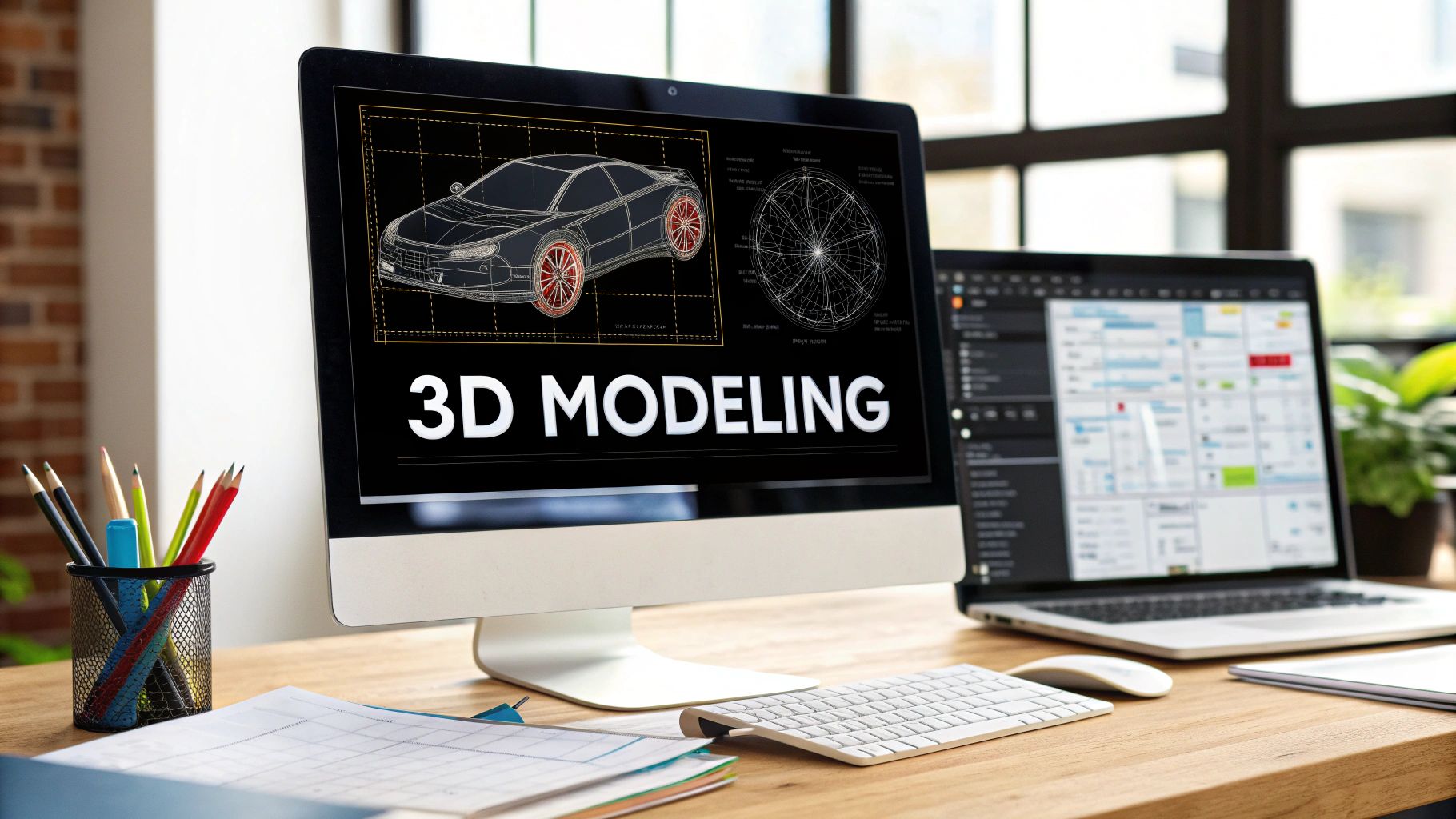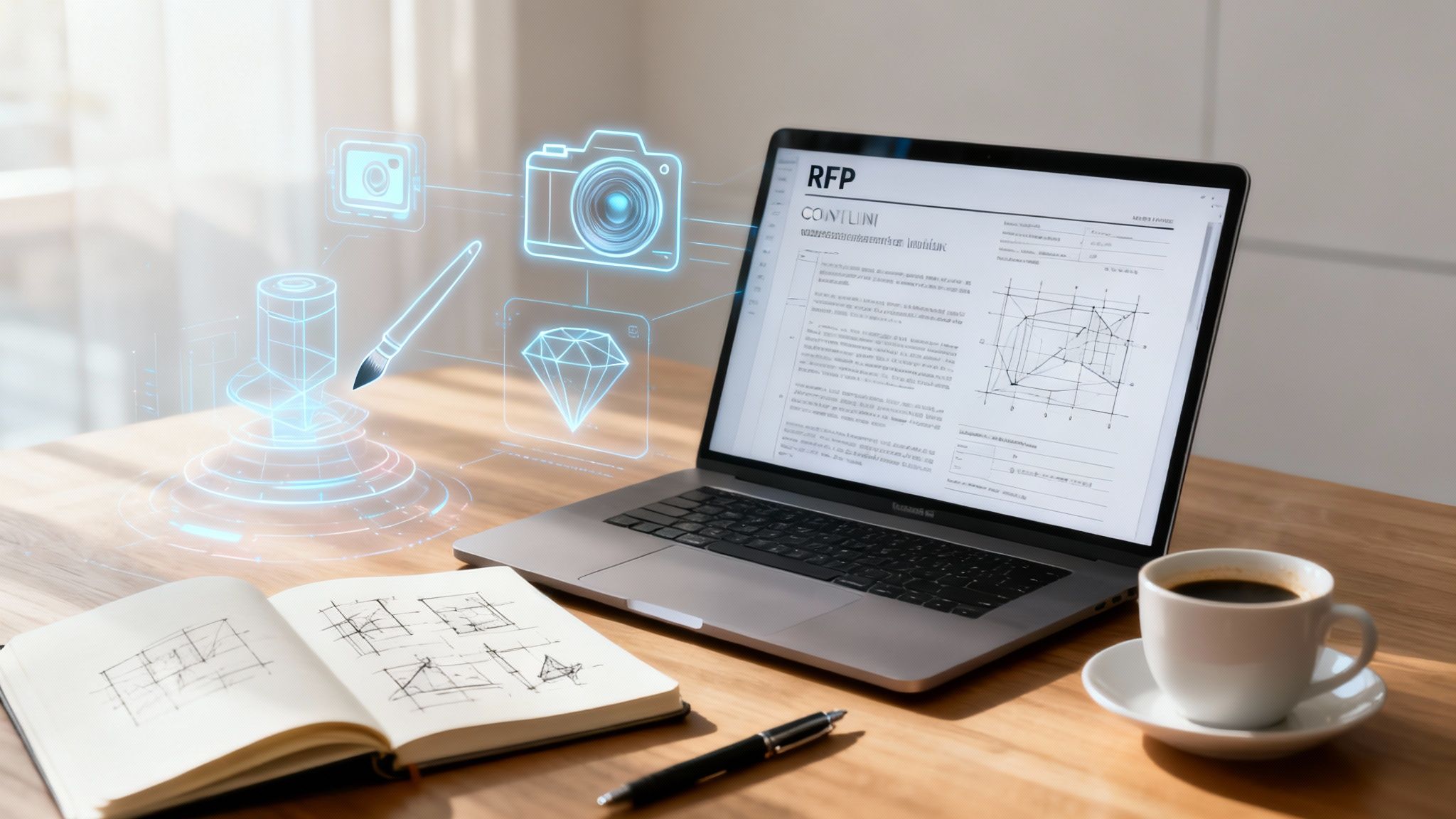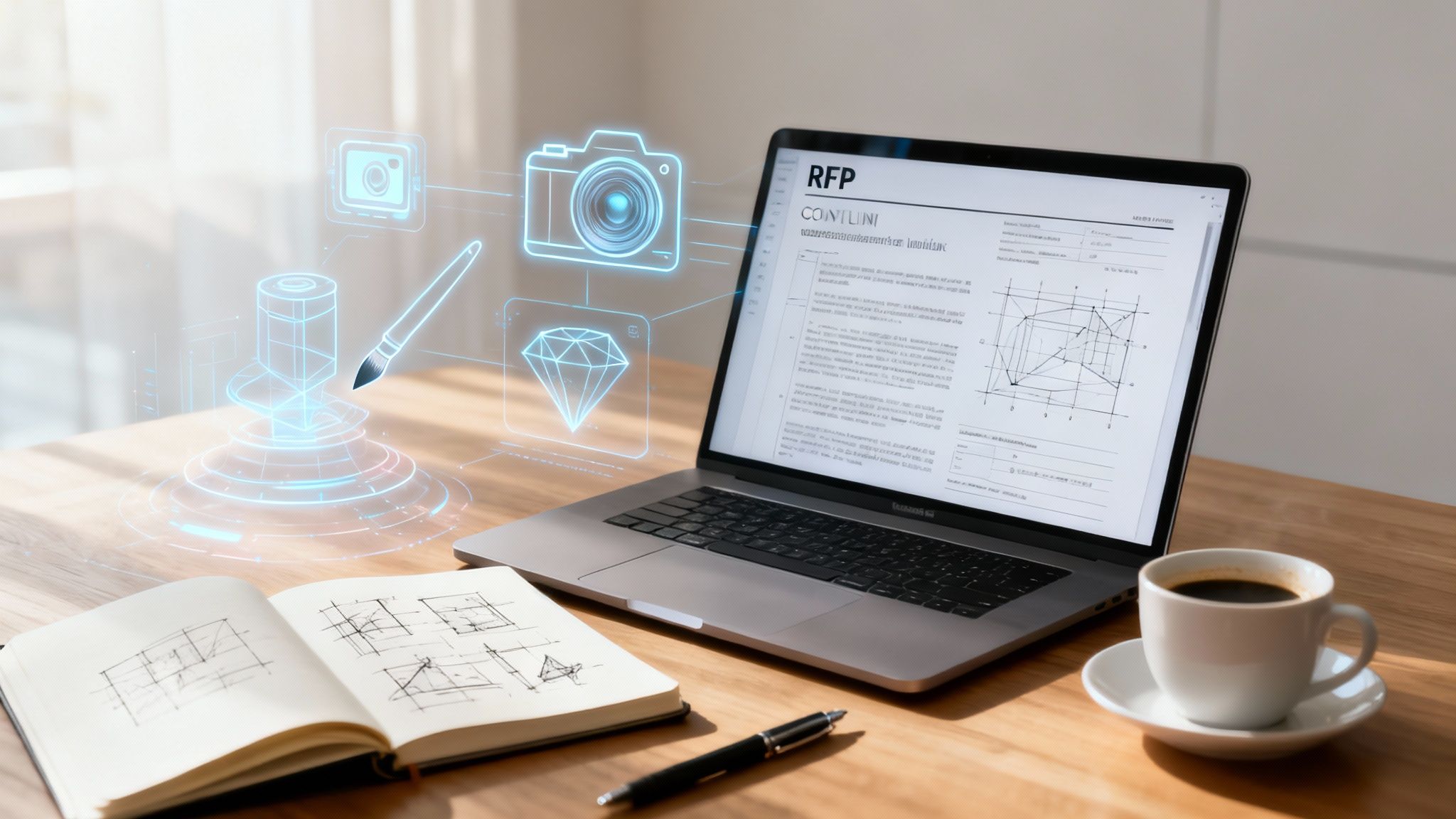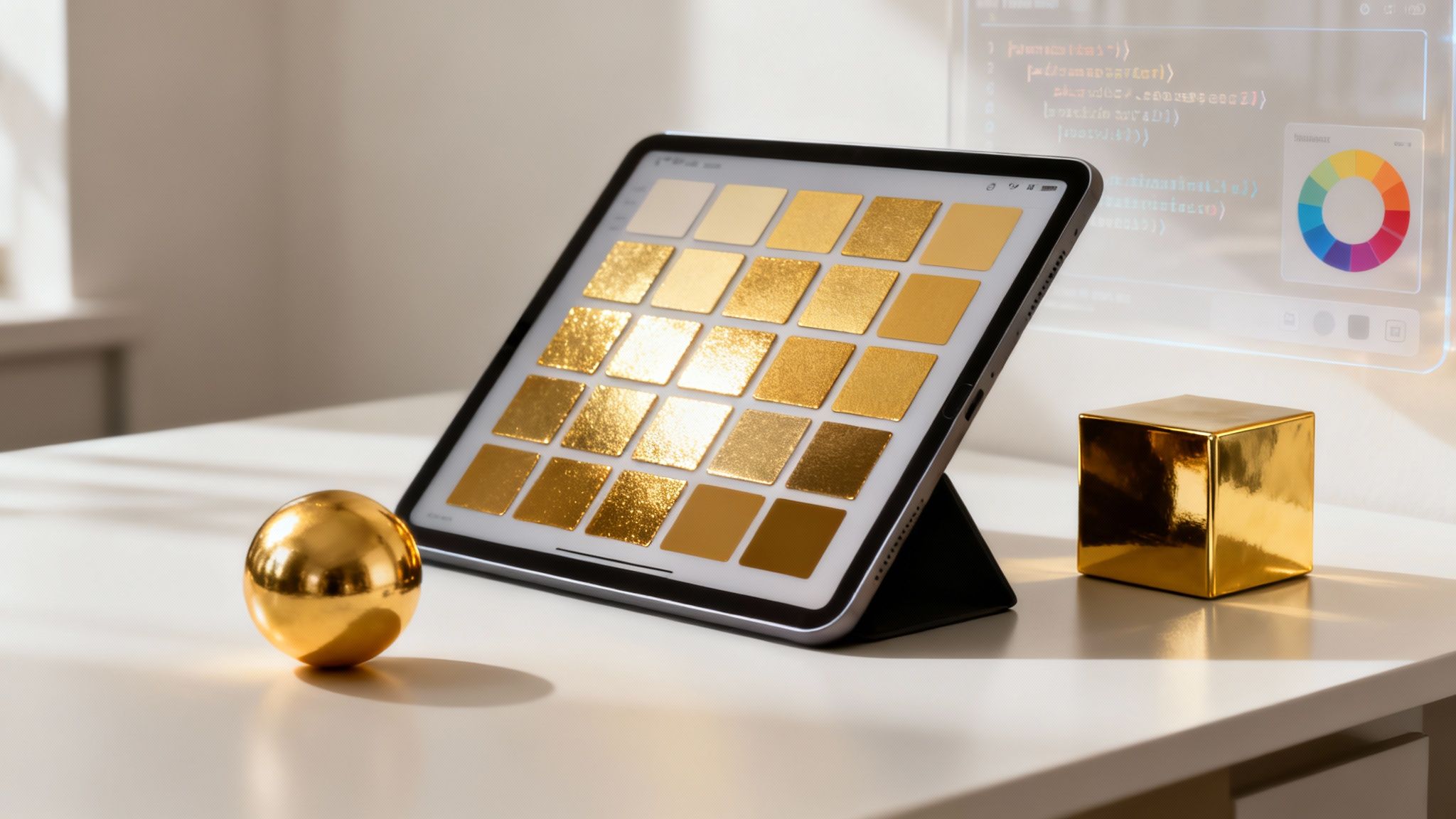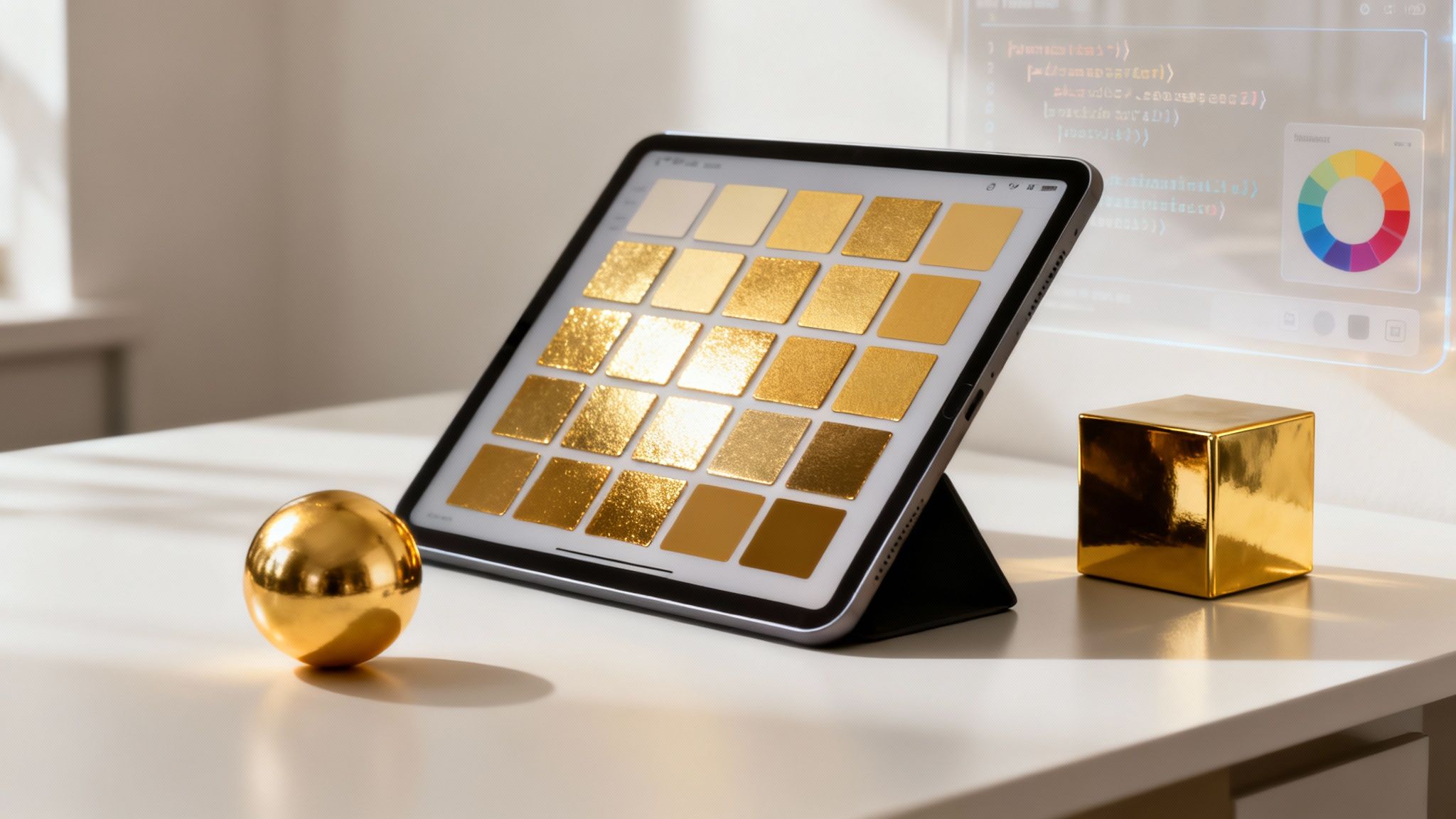Fundamentally, creating a 3D model is the process of converting a concept into a digital asset. The process begins with a 2D concept, which is then developed into a complex 3D mesh using specialized software and finalized with textures and materials. The concluding step is a polished render, prepared for its designated business application.
Your Foundation for Enterprise 3D Modeling
Embarking on 3D modeling for your business requires more than learning a new tool. It involves establishing a robust, secure, and scalable pipeline for your creative assets. A 3D model should be viewed as a digital file containing structured data—a mesh of vertices, edges, and faces that define an object’s geometry.
To build a strong foundation, a clear understanding of the workflow is essential.
Every professional 3D asset, from a product render to a complex simulation, adheres to a series of distinct stages. This structured journey from concept to a final, optimized product provides control, quality, and consistency—critical factors when managing numerous assets across multiple teams.
The Core 3D Modeling Workflow
Developing a professional 3D asset is a structured, repeatable process. Each stage builds upon the last, ensuring the final model meets both creative and technical specifications. This progression also serves as an effective project management framework, enabling clear milestone setting and team alignment.
The process commences with a concept and concludes with a finished, usable model. This infographic outlines the essential three-stage journey.
As illustrated, it is a clear, linear path. Ideation, modeling, and rendering are all integral parts of a single, integrated pipeline.
From Blueprint to Digital Asset
Understanding how to create 3D models means mastering the conversion of an abstract idea into a tangible digital asset. This is not merely an artistic pursuit; it is a technical discipline that requires meticulous planning and execution.
Consider a product designer sketching a new chair.
That initial sketch becomes the reference for constructing the initial geometric shape, or "mesh," in a program like Blender or Maya. The focus at this stage is on achieving correct proportions and maintaining a clean, efficient structure. Once the geometry is finalized, the artist applies textures and materials to simulate the appearance of wood grain, fabric, or metal, aiming for a high degree of realism.
Here is a high-level overview of the entire process, broken down into its four essential stages.
The Four Core Stages of 3D Model Creation
This structured approach is what distinguishes professional work from hobbyist projects. It guarantees quality and predictability from initiation to completion.
For enterprise teams, a well-defined workflow ensures that every 3D asset, whether for marketing, product design, or simulation, adheres to strict quality and brand standards, making the process both predictable and scalable.
Modern platforms are also introducing significant efficiencies into this process. AI tools, for example, can now accelerate the ideation phase or automate routine texturing tasks. This allows artists to concentrate on high-value creative decisions. It is a transformative development for accelerating production and maintaining consistency across large-scale projects.
Choosing Your Enterprise 3D Modeling Software

Selecting the right software to build 3D models is not just a creative choice—it is a significant business decision. For an enterprise, the evaluation must extend beyond features. It must encompass security, scalability, and integration with existing corporate systems.
Your software choice impacts everything from workflow efficiency and asset security to the effectiveness of global team collaboration.
While industry-standard tools like Autodesk Maya or the open-source platform Blender offer deep feature sets valued by artists, a large organization must consider the broader context. Does a tool integrate with your technology stack? Does it meet the company’s governance and security standards? These are the critical questions to address.
Evaluating Software Through an Enterprise Lens
When your team is tasked with producing thousands of high-quality, consistent assets, your software must function as more than a creation tool. It needs to be a secure hub that protects your intellectual property while enabling artists to perform at their best.
Before committing to a platform, consider these essential criteria:
- Integration Capabilities: How effectively does it connect with your project management system, DAM platform, or rendering pipeline? A disconnected workflow can introduce security vulnerabilities and operational inefficiencies.
- Security Protocols: Inquire about data encryption, both in transit and at rest. Robust access controls and clearly defined user permissions are necessary to protect proprietary models from unauthorized access.
- Collaborative Features: Can teams in different time zones work on the same files without creating versioning conflicts? Real-time feedback mechanisms and a central asset library are mandatory for modern creative teams.
- Vendor Support and Compliance: Is reliable, enterprise-level support available? The vendor should also be prepared to provide evidence of compliance with international data security standards.
For certain industries, like real estate, it is also advisable to evaluate specialized tools. For example, virtual home staging apps are built with features tailored specifically for that industry’s needs, which can provide a significant operational advantage.
The Rise of AI-Powered Platforms
While traditional software provides manual control, a new generation of AI-driven platforms like Virtuall is emerging, designed specifically for enterprise requirements. These systems are engineered to address the core challenges of security, scale, and consistency.
An AI-powered approach automates repetitive, time-consuming tasks. This allows for the generation of dozens of model variations from a single text prompt, all in perfect alignment with your brand’s style guide. This is not only faster; it enforces a level of consistency that is exceedingly difficult to maintain manually across a large team.
For an enterprise, the primary benefit of an AI platform is risk mitigation. By centralizing asset creation in a secure, controlled environment with a clear audit trail, you substantially reduce the probability of IP leakage or the creation of off-brand content.
Making a Future-Proof Decision
The right software choice supports current operations and provides capacity for future growth. A platform’s ability to scale with your team and adapt to new technologies is critical. This is an area where AI excels—its capabilities are continuously expanding to meet new creative and technical demands.
Ultimately, choosing your 3D modeling software requires a holistic view. You need a solution that empowers creativity without compromising on security or compliance.
You can explore a detailed 3D modeling software comparison to see how different tools measure up against these enterprise-critical needs. By focusing on integration, security, and scalability, you can make a choice that is not just compliant, but truly future-proof.
Mastering Core 3D Modeling Techniques
Once your team has the appropriate software, the primary work begins. Learning how to create 3D models involves mastering several essential techniques. These serve as the foundational building blocks for nearly any asset, from a product prototype to a character for a complex simulation.
Understanding these different approaches is critical. Each is designed for a specific application. A product design team might use one technique for precise engineering parts and a completely different one for organic marketing visuals. Knowing when to use each method is fundamental to an efficient production pipeline.
The 3D modeling market is expanding rapidly, with projections showing it will reach $10.3 billion by 2025. This growth is accelerated by AI tools that are automating complex tasks and streamlining design work. You can explore how generative AI is changing 3D design and its implications for creators.
The Foundation: Polygonal Modeling
The most common technique is polygonal modeling. This can be compared to digital construction. You build an object’s surface using a mesh of simple geometric shapes: vertices (points), edges (lines), and polygons (faces).
An artist typically starts with a primitive shape—such as a cube or a sphere—and begins manipulating these components. They might move a vertex to create a sharp corner on a building or extrude a polygon to form the arm of a chair. It is a methodical process that offers complete control, making it ideal for hard-surface objects that require clean lines and defined structures.
For example, an architectural firm uses polygonal modeling to create a precise digital twin of a building, where every window, door, and beam can be constructed with absolute accuracy.
The Art of Digital Sculpting
While polygonal modeling is akin to building with blocks, digital sculpting is more comparable to working with digital clay. Instead of adjusting individual points and lines, artists use brush-based tools to push, pull, smooth, and pinch the surface of a high-resolution mesh.
This approach is highly intuitive and allows for the creation of detailed, organic shapes that would be exceptionally difficult to build with traditional polygon methods. It is the preferred technique for assets such as:
- Character Models: Creating realistic wrinkles, muscle definition, and facial expressions.
- Natural Environments: Sculpting detailed rocks, terrain, and tree bark.
- Intricate Details: Adding complex decorative patterns or surface damage to props.
The result is often a "high-poly" model with millions of polygons. This detail is excellent for creating photorealistic textures, but it usually requires optimization for real-time applications—a topic addressed later.
In an enterprise context, digital sculpting is invaluable for creating high-impact marketing assets. An automobile manufacturer could use it to perfect the subtle curves on a new vehicle for a promotional video.
The true power lies in combining these techniques. Many professional workflows begin with a basic polygonal mesh to establish the core structure and then transition to digital sculpting to add fine details.
Precision with NURBS Modeling
For industries where mathematical precision is paramount, NURBS (Non-Uniform Rational B-Splines) modeling is the industry standard. Unlike polygons, NURBS use complex mathematical curves to define surfaces. The result is perfectly smooth surfaces that can be scaled to any size without any loss of detail.
This method is essential in fields like:
- Industrial Design: Creating exact parts for manufacturing, such as a phone casing or an engine component.
- Automotive and Aerospace: Designing aerodynamic car bodies where every curve is critical.
- Product Prototyping: Ensuring a digital prototype matches the exact specifications for physical production.
Because NURBS models are based on mathematical formulas, they are incredibly accurate and easy to modify. Changing a curve is as simple as adjusting a control point, and the entire surface updates seamlessly. It is an indispensable tool for engineering and manufacturing professionals.
You can learn more about how AI is automating and accelerating even these traditional, precision-based techniques in our guide to how to generate 3D models from a prompt.
Applying Textures and Materials for Realism
A wireframe is merely a digital skeleton. The model truly comes to life when realistic surfaces are applied. This is the function of texturing and material application, which transforms a sterile mesh into a believable object.
The first critical step is UV mapping. This process is analogous to carefully unwrapping a gift box until it lies perfectly flat. The same principle is applied to a 3D model—unfolding its surface into a 2D plane so that textures can be applied without distortion or stretching.
Correctly executing this step is foundational to a professional-looking asset. It ensures a wood grain texture flows naturally around a table leg instead of appearing stretched and artificial.
Building Believable Surfaces with PBR
Once the model is unwrapped, you can begin to build its materials using a Physically Based Rendering (PBR) workflow. This approach does not simply imitate what a surface looks like; it simulates how light actually interacts with it in the real world. A PBR material is not a single flat image but a collection of specialized texture maps working in concert.
- Diffuse Map: This defines the base color of the object, such as the red paint on a fire hydrant or the brown tones of a leather chair.
- Normal Map: This map creates the illusion of fine surface details—like the pores on skin or the weave in a fabric—without increasing the model's polygon count.
- Roughness Map: This map dictates how light scatters across a surface. A smooth, non-rough surface like polished chrome will be shiny and reflective, while a high-roughness surface like concrete will be dull and matte.
By layering these maps (and others), you can accurately recreate almost any material imaginable, from brushed aluminum to rough-hewn stone. It is this methodical approach that gives modern 3D assets their striking realism. The demand for these skills is increasing, with the 3D mapping and modeling market projected to grow from $7.6 billion in 2025 to $22.19 billion by 2032.
For a business, a PBR workflow offers more than just aesthetic quality—it ensures consistency. When you define materials with real-world physical properties, you guarantee that a product appears identical under any lighting conditions, whether in a marketing render, an AR application, or a training simulation.
Centralizing Materials for Enterprise Consistency
For any large organization, managing materials across hundreds or thousands of assets presents a significant challenge. The only scalable solution is to establish a centralized, curated library of your brand’s PBR materials. This library becomes the single source of truth for your visual identity in 3D.
A shared material library offers several key advantages:
- Brand Consistency: It guarantees that your company’s specific shade of blue or patented metal finish is applied correctly on every model, every time, without deviation.
- Quality Control: All materials are pre-approved and optimized, preventing artists from using incorrect or low-quality textures that could compromise a project's quality.
- Efficiency Boost: Artists can pull approved materials directly from the library instead of creating them from scratch, which drastically accelerates the entire production pipeline.
This structured approach transforms your texturing process from a series of individual artistic choices into a controlled, scalable system. Professionalizing your material pipeline is a critical step toward building a reliable and efficient 3D content engine.
Optimizing and Exporting Your 3D Models
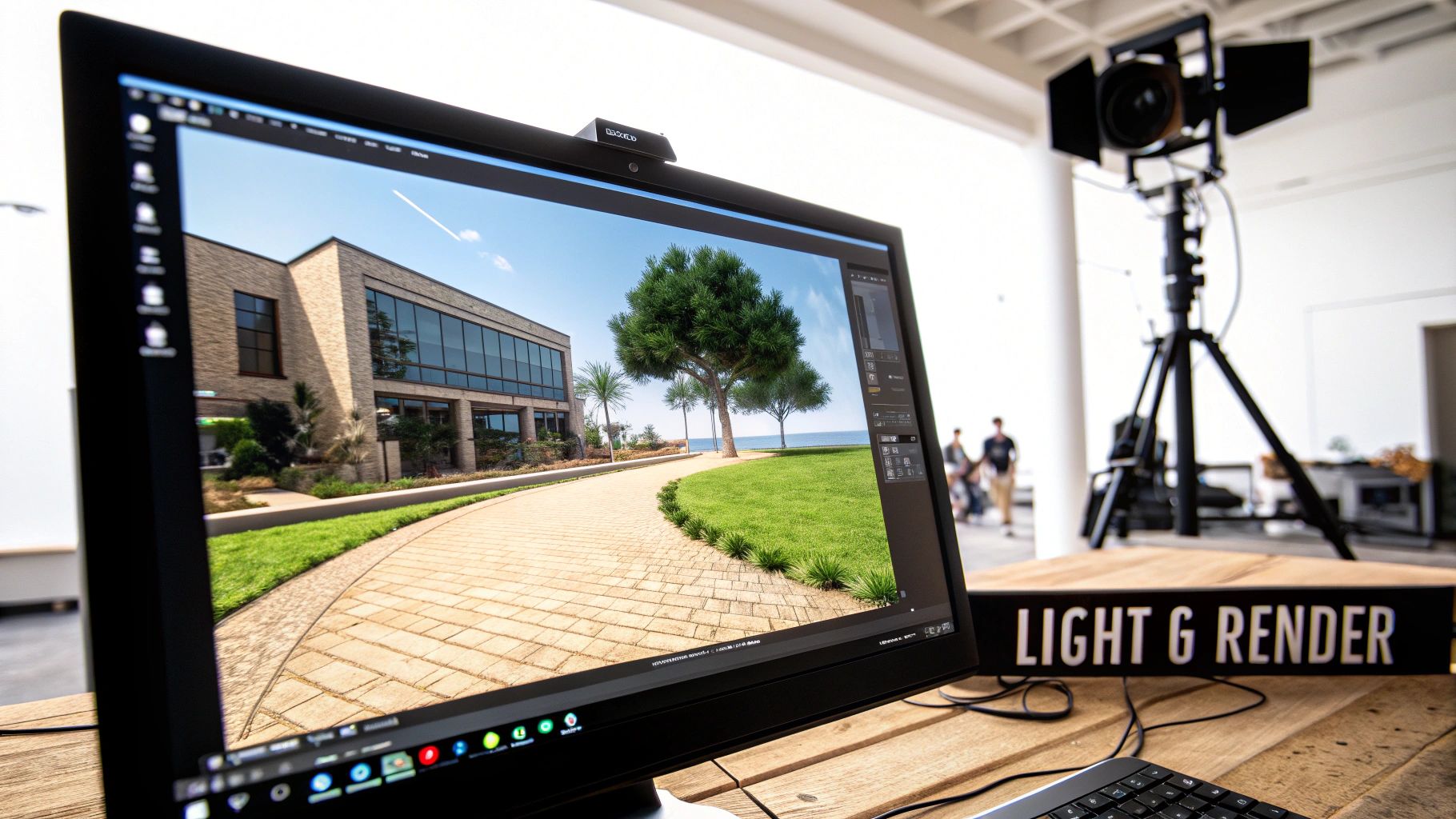
You have constructed a detailed, high-quality 3D model. However, this asset is of little use if it causes an application to crash or takes an unreasonable amount of time to load on its intended platform.
This final stage—optimization and exporting—is where a detailed asset is transformed into a lean, efficient file ready for real-world application.
For any real-time use case, such as AR, VR, or interactive product viewers, this is not just a beneficial step; it is a mandatory requirement. Smooth performance is paramount.
The Art of Retopology
After the sculpting phase, you are typically left with a "high-poly" mesh, often comprising millions of polygons that capture every minute detail. While this looks impressive in a cinematic render, it is far too dense for real-time engines.
This is where retopology becomes necessary.
It is the process of constructing a new, clean, low-polygon mesh that traces the surface of the high-detail sculpt. The objective is to preserve the model's form and silhouette while significantly reducing the polygon count. This makes the asset performant, predictable, and suitable for animation.
Retopology is more than just polygon reduction. It is a strategic process to ensure the model deforms correctly during animation and adheres to the technical constraints of its target platform. It is a cornerstone of a reliable 3D pipeline.
Implementing Levels of Detail
In an interactive scene, a model does not need to be rendered in full detail when it is distant from the viewer. This is where Levels of Detail (LODs) are essential for performance optimization.
LODs are simply different versions of the same model, each with a progressively lower polygon count. The application or game engine automatically swaps these versions based on the viewer's distance.
- LOD0: The highest quality version, used for close-up viewing.
- LOD1: A moderately detailed version for mid-range viewing.
- LOD2: A very low-poly version for objects in the far distance.
This technique ensures that processing power is allocated efficiently, maintaining high frame rates and a smooth user experience without sacrificing visual quality where it matters most.
Preparing for Export
Once your model is optimized, the final step is to export it in a standardized file format. This choice is critical and depends entirely on the model's destination. An incorrect format can lead to compatibility issues or data loss.
This is particularly important as the U.S. 3D mapping and modeling market, valued at an estimated USD 3.0 billion in 2024, continues to expand and demand greater interoperability.
Beyond file formats, forward-thinking teams also implement broader improvements like workflow automation to accelerate the entire pipeline from creation to delivery.
Here is a brief overview of the most common formats.
Common 3D File Format Comparison
Choosing the right file format is like selecting the correct tool for a specific task. Each has strengths and is designed for a particular purpose, from complex game animations to simple web viewers. This table outlines the essentials.
By mastering these final optimization and export steps, you can ensure every 3D asset is not just a visually appealing object, but a performant, reliable, and technically sound file ready for any platform. This attention to detail is what transforms creative work into robust, enterprise-grade assets.
Got Questions About Enterprise 3D Modeling?
Adopting enterprise-level 3D modeling raises numerous questions. Teams frequently encounter challenges related to security, scalability, and efficiency. Addressing these areas correctly is the difference between a smooth, creative workflow and one that is inefficient and high-risk.
We consistently receive similar inquiries from teams like yours. Let's address them.
How Do We Keep Our 3D Assets Secure?
Your intellectual property is a critical asset. Protecting it begins with selecting software that has security built in by design. This includes strong access controls to manage user permissions, end-to-end encryption for files in transit and at rest, and audited, secure cloud storage.
However, tools are only part of the solution. It is imperative to establish clear internal policies for asset management. This involves defining how proprietary models are shared, who is authorized to download them, and the protocols for securely onboarding external collaborators.
Enterprise-grade platforms often hold compliance certifications and include dedicated IP protection features. These serve as an additional layer of security, providing assurance that your most valuable digital assets are protected.
A truly secure pipeline is a combination of appropriate technology and disciplined internal processes.
What's the Best Way to Manage a Huge Library of 3D Models?
As a library grows from a few models to thousands, a basic shared drive with a simple folder structure becomes unmanageable. The only sustainable solution is a Digital Asset Management (DAM) system designed to handle the complexities of 3D files.
When evaluating a DAM, ensure it includes these key features:
- Rock-Solid Version Control: The system must track every change, allowing you to revert to previous versions and preventing artists from accidentally overwriting each other’s work—a common and costly error.
- Smart Metadata Tagging: The ability to tag assets with rich details—project name, artist, polygon count, usage rights—is essential for making your library searchable and useful.
- Seamless Integration: Your DAM must integrate directly with your team's modeling and rendering tools, allowing artists to check files in and out without disrupting their creative workflow.
A proper DAM eliminates costly rework and versioning conflicts. More importantly, it empowers your entire team to find and reuse approved assets efficiently, resulting in a significant productivity gain.
How Can AI Actually Speed Up Our 3D Modeling?
AI is no longer a future concept; it is a practical tool that can deliver tangible benefits to your workflow today. AI-powered platforms can automate routine, time-consuming tasks, freeing your artists to focus on higher-value creative work.
Here is how it functions in a practical setting:
- Automated Retopology & UV Unwrapping: AI can now manage the technical and often tedious process of creating a clean, application-ready mesh and unwrapping it for texturing. This can save hours of manual labor on a single asset.
- Super-Fast Concept Generation: Instead of starting from scratch, artists can use a simple text prompt or a 2D image to generate dozens of 3D concepts in minutes, fundamentally changing the initial ideation phase.
- Instant Textures and Materials: AI can generate realistic PBR materials or apply textures from simple descriptions, ensuring visual consistency and dramatically accelerating the texturing stage of a project.
By integrating AI into your pipeline, your team can produce assets faster and achieve a higher, more consistent standard of quality. It allows your most talented personnel to direct and refine creative output, rather than focusing on repetitive tasks.
Ready to enhance efficiency and accelerate creation? Virtuall is an all-in-one platform for generating, managing, and collaborating on 3D models in a secure, enterprise-ready workspace. It's time to transform your workflow and empower your team to create at the speed of thought.
See what you can build at https://virtuall.pro.

